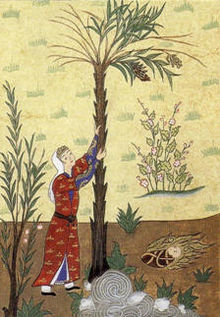| Muhja bint al-Tayyani | |
|---|---|
| Born | 11th century Córdoba, Al-Andalus (now Spain) |
| Died | 1097 Córdoba, Al-Andalus (now Spain) |
| Occupation | Poet |
| Language | Arabic |
| Nationality | Andalusian |
| Notable works | Satires and love poems |
Muhja bint al-Tayyani al-Qurtubiyya (Arabic: مهجة بنت التياني القرطبية) (born in Córdoba, died in Córdoba 1097 CE) was an eleventh-century Andalusian poet.
She was the daughter of a Cordoban merchant who was engaged in the sale of figs. At some point, she met the famous poet Princess Wallada, who took her into her house — which served as a school of poetry for women — and mentored her. Muhja became a celebrated poet, a profession that had a great recognition in Andalusian society. Wallada was extremely fond of Muhja, writing her passionate (and rather explicit) love poetry, and there are suggestions they may have been lovers.
Poems

Muhja dedicated ferocious satires to her teacher:
| Original | Transliteration (ALA-LC) | Literal translation |
| وَلّادة قَدْ صِرْتِ وَلّادة | Wallādah qad ṣirti wallādah
min ghayri baʿalin faḍaḥa al-kātimu ḥakat lanā Maryam lākinnah nakhlat hādhī dhakaru qāʾimu. |
Wallada has become fecund
by another man; the secret-keeper revealed it. To us, she resembled Mary, but this palm-tree is an erect penis. |
This poem puns on Wallada's name, which literally means 'fecund'. It compares Wallada, ostensibly pregnant out of wedlock, to the Virgin Mary. The poem shifts from a literary register in the first half to a colloquial one in the second (characterised by the colloquial form hāḏī in place of classical hāḏihi). The second half alludes specifically to the Islamic account of the virgin birth, in which Mariam received a divine instruction to shake the trunk of a date palm while giving birth to Jesus, so that its fruits fall down to her. In Muhya's account, Wallada has grasped a penis to similar effect.
Another example is this verse:
|
يا متحفا بالخوخ أحبابه |
Away from the gouache of his lips |
Further reading
Sobh, Mahmud (2002), "Wallada bent al-Mustakfi. Muhya bent al-Tayyani", Historia de la literatura árabe clásica, Madrid: Cátedra, pp. 952–957.
References
- ^ Medievalists.net (2022-04-21). "Fit for High Positions: The Life of Wallada bint al-Mustakfi". Medievalists.net. Retrieved 2024-05-22.
- Montefiore, Simon Sebag (2023-05-16). The World: A Family History of Humanity. Knopf Doubleday Publishing Group. ISBN 978-0-525-65954-9.
- ^ Chinca, Mark; Young, Christopher (2022-08-25). Literary Beginnings in the European Middle Ages. Cambridge University Press. ISBN 978-1-108-47764-2.
- Viguera, MJ (1989). La mujer en Al-Andalus. Sevilla: Universidad Autonoma de Madrid.
- Hole, Edwyn (1958). Andalus: Spain Under the Muslims. R. Hale.
- Joseph, Suad; Najmabadi, Afsaneh (2003). Encyclopedia of Women & Islamic Cultures. Brill. ISBN 978-90-04-11380-0.
- Garulo, T (1998). Diwan de las poetisas de Al-Andalus. Madrid: Hiperión.
- Garulo, T (1998). Diwan de las poetisas de Al-Andalus. Madrid: Hiperión.
- "قصيدة: ولّادة قد صرتِ ولّادة".